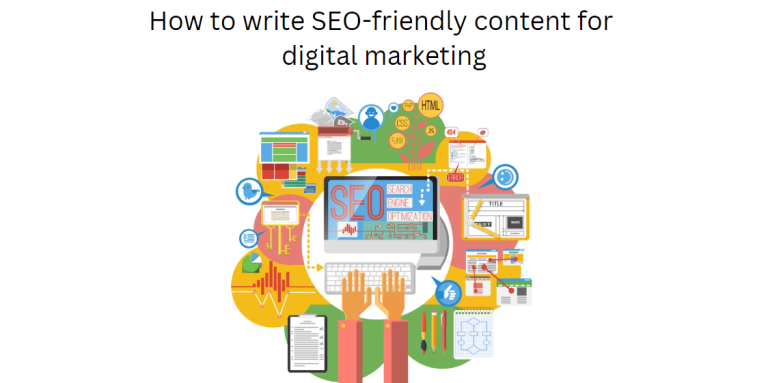The most crucial thing you can do for your content is to optimise it for users and search engines. But producing SEO-friendly content frequently takes time and effort. But if you do them correctly, you can count on them to pay off in the end.
Today, SEO is both a science and an art. Understanding search engine ranking factors, prioritising searcher intent, and publishing valuable, high-quality content that appeals to users and Google’s algorithms are requirements for content writers and digital marketers.
Even the best-written articles are useless if no one ever visits your page. It goes without saying that you must create SEO-friendly content if you want your business to succeed. I’ll share some advice for creating SEO-friendly articles in this article that will be useful for digital marketing.
What is SEO-friendly content?
SEO-friendly content is content that is written in such a way that it ranks well in search engines. While some marketers mistakenly believe that this calls for stuffing it with keywords, the real purpose of this is to make your content easier for search engines to find, comprehend, and relate to the subject matter you’re trying to cover. You can give Google more information about your page’s subject matter by writing with SEO best practises in mind. which Google may use to decide if your page is appropriate for a user’s search.
Tips to write SEO-friendly content for digital marketing
These guidelines can help you learn how to write SEO content that ranks, whether you’re just getting started or an experienced pro:
Start with research
The goal of a user’s search is referred to as search intent. The search intent of the keyword you want to rank for will affect the content format you select, the message you present, and the call to action you include. For navigational or informational purposes, searchers use keywords to find a particular website or page. If your brand is well-known and you receive direct traffic, targeting these queries will work better for you.
Go with keyword research
Although SEO is moving more in the direction of enticing users to produce thought-leadership content, keywords are still very important. By selecting the appropriate keywords, you can dominate search results and please your target audience. Pay attention to long-tail keywords. Despite having a low search volume, they still offer a high chance of appearing on the SERPs. Longer keyword phrases are typically used by people looking for more detailed information on a particular subject. Use keyword research tools like Ahrefs, SemRush, Keyword Planner, UberSuggest, etc.
Use headlines and sub-headers
When used for SEO optimization, headlines and sub-headers serve several purposes. The first benefit is that it makes your writing skimmable, which makes it easier for readers to read. Things that are simple to read are more likely to be shared.
Robots from search engines operate similarly. They will be able to identify your headlines as they crawl through your website and use them to better understand your content, such as which sections are the most crucial, etc.
Write and Optimize the body article
Adhere to a strong structure if you want to produce excellent content. Determine the main point of your post first. Your writing will be simpler and more efficient if you divide it into several sections. Once you’ve organised your content, you can work on each section independently without having to spend time planning your ideas.
Because Google has demonstrated that it prioritises longer, higher-quality content, they strive to give their users the best solutions, which frequently comes down to having posts that give the most comprehensive response to the user’s query. Use resources like the paraphrasing tool to optimise your content so that you have a better chance of getting clear and concise wording.
Adding internal and external links
Include any terms, figures, or points that need more explanation whenever you write a new blog post. This means that you should continue to include both internal and external links in your article. They assist your readers in delving deeper into a subject while maintaining attention on the key idea.
Internal links lead visitors from one page of your website to another. Search engines can better understand your site’s structure and how your pages relate to one another when you strategically interlink your content. Additionally, this points visitors to other worthwhile, pertinent pages on your website that may result in conversions.
Building trust and enhancing the user experience are two benefits of linking to relevant external resources like Wikipedia. Additionally, you should include descriptive anchor text in the links so that users can understand what the link is about. Make an effort to only use a few links.
Add Visual Content
Visual content can present complex information in a way that is simple to understand. Furthermore, it succeeds on social media. Use infographics, checklists, templates, and other visual content to give your audience useful information in an engaging way. This could enhance on-page behaviour signals and the user experience. The ability of the images or videos you include in your copy to rank in Google’s Image and Video sections is another advantage of visual content.
Enable sharing of the content
You’ve thus succeeded in creating a compelling, SEO-friendly article that people want to read. Making it shareable is the next step. Social media sharing buttons can be easily added to your website using websites like “Share This” and “Add This.” Make it simpler for users to locate your social share buttons so they can promote your content online.
Bottom Lines
Learning how to write content for your website that is SEO-friendly will take some time, but it will be well worth it in the end. To write SEO-friendly content and get the most out of your copywriting efforts, use these useful tips. They will assist you in making sure that quality content generates more shares, leads, links, and returning users.


